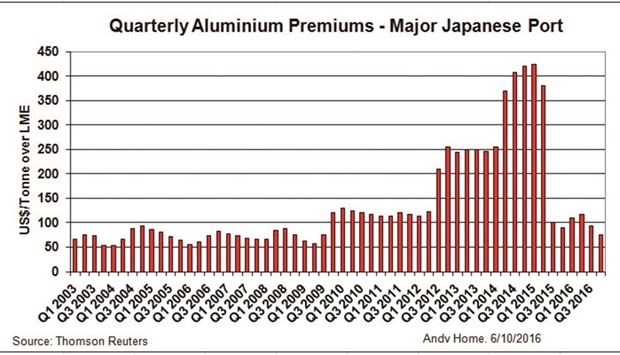Japanese aluminium buyers will pay a premium of $75 per tonne over the London Metal Exchange (LME) cash price for their shipments in the fourth quarter of this year.
The settlement with producers, which will serve as the benchmark for Asian physical aluminium markets, marks a near 20% decline from the previous quarterly premium of $90-93 per tonne and is the lowest level since the third quarter of 2009.
This is the continuing unwind of the premium bubble that grew out of the load-out queues at LME warehouses in Detroit and the Dutch port of Vlissingen.
Japanese users were paying $425 per tonne in the first quarter of 2015, a period which marked the worst of the fracturing of the aluminium price between LME paper and physical premium markets.
We are now in the post-queue world and premiums are returning to their previous function of delineating regional supply and demand dynamics.
Quite evidently, there remains significant oversupply in the aluminium market.
Physical premiums everywhere else are also at or near historical lows.
But the tail winds from the queues are still discernible, determining where that oversupply appears.
Japanese buyers have successfully pushed through such a significant drop in quarterly premiums by arguing that the spot market is even weaker, recently trading as low as $70 per tonne.
There are multiple factors at work in suppressing the Japanese premium right now. Japanese stocks of aluminium have been trending lower but at 304,200 tonnes at the end of August are still high by historical standards.
Local demand is running at subdued levels, output of rolled products, for example, falling 1% from year-earlier levels in July and August, according to the Japan Aluminium Association.
Freight rates, a key component of physical market premiums, are bombed out.
And both Japan and the wider Asian region are battling against the continued export flow of semi-manufactured products out of China.
Exports may be down around 5% year-on-year but China is still pumping out around 350,000 tonnes per month of products, most of it into other Asian countries, displacing primary metal demand.
Interacting with these drivers is leakage of metal from off-market financing deals, a trade predicated on the structure of the LME forward curve.
A profitable financing trade needs a sufficiently wide contango on the LME to cover the costs of storage.
As of the close of business on Wednesday the cash-to-three-months period was valued at $8.25 contango.
This time last month it was $19 per tonne and the spread has since flirted with backwardation, a structure that makes it unviable to hold metal, even in the cheapest storage options.
And rewind a year or so and that spread was consistently trading as wide as $40, manna from heaven for aluminium financiers.
Moreover, “tom-next”, the price of rolling a position one day forwards, is experiencing persistent tension.
The shortest-dated spread in the LME system flared out to $10 backwardation at times in September and even this morning traded briefly into small backwardation.
The trend is towards tighter LME spreads and when the curve undergoes one of its ever more frequent contractions, finance deals aren’t renewed, releasing more metal into both physical and LME markets.
The tail winds from the load-out queues are both acting to tighten those spreads and determine where metal appears back in the LME system. There is still a load-out queue at Vlissingen sheds operated by Access World, the logistics arm of Glencore.
Its direct impact on physical premiums has been broken by the LME’s concerted attack on the queue model, a mixture of enforced faster load-out rates and rent relief for those awaiting their delivery slot.
Vlissingen has been for many months the driver of falling headline LME stocks and the accompanying decline in free-float aluminium in the system, the stuff that can be used for physical settlement of positions.
The lower the level of free-float stocks, the greater the potential for spread contractions, particularly in aluminium where the LME’s futures banding report shows super-large positions liberally distributed across the next three main prompt dates.
Every time the spreads contract, there is a reaction in terms of metal being warranted into the LME system.

Andy Home is a columnist for Reuters. The views expressed are those of the author.


